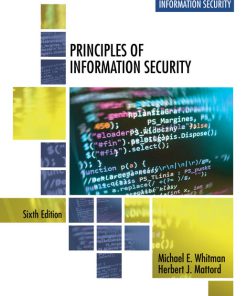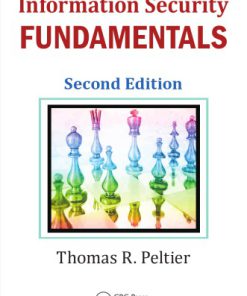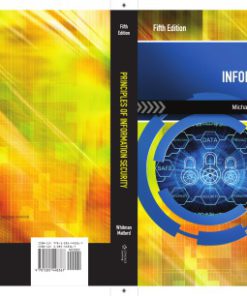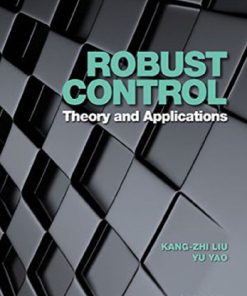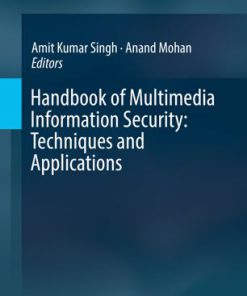Information Security Applications 1st edition by Kiwook Sohn, Moti Yung 3642003066 9783642003066
$50.00 Original price was: $50.00.$25.00Current price is: $25.00.
Information Security Applications 1st edition by Kiwook Sohn, Moti Yung – Ebook PDF Instant Download/DeliveryISBN: 3642003066, 9783642003066
Full download Information Security Applications 1st edition after payment.

Product details:
ISBN-10 : 3642003066
ISBN-13 : 9783642003066
Author: Kiwook Sohn, Moti Yung
This book constitutes the thoroughly refereed post-conference proceedings of the 9th International Workshop on Information Security Applications, WISA 2008, held in Jeju Island, Korea, during September 23-25, 2008. The 24 revised full papers presented were carefully reviewed and selected from a total of 161 submissions. The papers are organized in topical sections on smart card and secure hardware, wireless and sensor network security, public key crypto applications, privacy and anonymity, n/w security and intrusion detection, as well as application security and trust management.
Information Security Applications 1st Table of contents:
- Smart Card and Secure Hardware(1)
- Using Templates to Attack Masked Montgomery Ladder Implementations of Modular Exponentiation
- Introduction
- Masked Montgomery Powering Ladder
- Principle of Template Attacks
- Mask Filtering
- Sieving with Tolerance
- Practical Attack
- Results
- Conclusions
- References
- Template Attacks on ECDSA
- Introduction
- Template Attacks
- Template Building Phase
- Template Matching Phase
- Previous Work
- Our Contribution
- ECDSA and Power Analysis Attacks
- ECDSA Signature Generation
- Security of Implementations of ECDSA
- Template-Based SPA Attacks on ECDSA
- Three Observations for Practical Applications
- Different Scenarios for Practical Attacks
- Practical Template-Based SPA Attacks on EC Point Multiplication
- Template Building Phase
- Template Matching with Pre-computed Templates
- Template Matching with On-the-Fly Created Templates
- Countermeasures
- Conclusion
- References
- Compact ASIC Architectures for the 512-Bit Hash Function Whirlpool
- Introduction
- The 512-Bit Hash Function Whirlpool
- Compact Hardware Architectures
- Data Manager
- Datapath Architectures
- Performance Evaluation
- Conclusion
- References
- Wireless and Sensor Network Security(1)
- Improved Constant Storage Self-healing Key Distribution with Revocation in Wireless Sensor Network
- Introduction
- Overview of Dutta’s Scheme
- Security Model of Dutta’s Scheme
- Protocol Requirements
- Self-healing Session Key Distribution
- Attack To Dutta’s Scheme
- The Proposed Scheme 1
- Security Model of the Proposed Scheme
- The Proposed Scheme 1
- Security Analysis of Scheme 1
- The Proposed Scheme 2
- The Construction of Scheme 2
- The Security Analysis of Scheme 2
- Efficiency
- Conclusion
- References
- Advances in Ultralightweight Cryptography for Low-Cost RFID Tags: Gossamer Protocol
- Introduction
- A Family of Ultralightweight Mutual Authentication Protocols
- Security Analysis of the UMAP Protocols
- SASIProtocol
- Vulnerability Analysis
- Gossamer Protocol
- Model Suppositions
- The Protocol
- Security Analysis
- Performance Analysis
- Conclusions
- General Considerations
- Ultralightweight Protocols
- References
- Securing Layer-2 Path Selection in Wireless Mesh Networks
- Introduction
- Related Works
- Path Selection Mechanism in 802.11s
- Possible Attacks
- Flooding Attack
- Route Re-direction Attack
- Routing Loops
- Proposed Secure Layer-2 Path Selection (SLPS) Protocol
- Key Establishment
- Identifying Mutable and Non-mutable Fields
- Secure Route Discovery
- Security and Overhead Analyses
- Security Analysis
- Overhead Analysis
- Performance Evaluation
- Conclusions
- References
- Public Key Crypto Applications
- Public Key Authentication with Memory Tokens
- Introduction
- Authentication Techniques
- Approaches for Authentication
- Merkle Signatures
- Authentication without Calculations
- Generating Signatures without Calculations
- Authentication Protocol
- Comparison
- Implementation and Applications
- Memory and Resource Requirements
- Hardware Implementation
- Applications
- Conclusion
- References
- Certificate-Based Signatures: New Definitions and a Generic Construction from Certificateless Signat
- Introduction
- Certificate-Based Signatures: Pros and Cons
- Related Works about Certificate-Based Signatures
- Motivations and Contributions
- Certificate-Based Signatures
- Syntax of Certificate-Based Signatures
- Adversaries and Oracles
- Security Models
- Security against Normal Type I Adversary
- Security against Strong Type I Adversary
- Security against Super Type I Adversary
- Security against Type II Adversary
- Generic Construction of Certificate-Based Signatures
- Syntax of Certificateless Signatures
- Generic Construction: {sf CLS-2-CBS}
- Conclusion
- References
- Cryptanalysis of Mu et al.’s and Li et al.’s Schemes and a Provably Secure ID-Based Broadcast Si
- Introduction
- Preliminaries
- Bilinear Pairing
- Computational Diffie-Hellman Problem (CDHP)
- ID-Based Broadcast Signcryption (IBBSC)
- Framework of ID-Based Broadcast Signcryption (IBBSC)
- Security Model for ID-Based Broadcast Signcryption
- Overview of IBBSC Scheme of Mu et al.
- Attack on IBBSC Scheme of Mu et al.
- Overview of IBBSC Scheme of Li et al.
- Attacks on IBBSC Scheme of Li et al.
- Attack on Confidentiality
- Attack on Authentication
- Improved ID-Based Broadcast Signcryption Scheme
- Proof of Confidentiality of Our IBBSC Scheme
- Proof of Unforgeability of Our IBBSC Scheme
- Efficiency of Our IBBSC Scheme
- Conclusion
- References
- Privacy and Anonymity
- Sanitizable and Deletable Signature
- Introduction
- Preliminaries
- Aggregate Signature
- Sanitizable Signature
- Deletable Signature
- Proposed Schemes
- Concept
- Approach
- Subdocument Status
- Proposed Scheme 1 (SDS1)
- Proposed Scheme 2 (SDS2)
- Comparison
- Concluding Remarks
- References
- An Efficient Scheme of Common Secure Indices for Conjunctive Keyword-Based Retrieval on Encrypted Da
- Introduction
- Preliminaries
- Models
- Assumptions
- Construction
- Wang {it et al.} Dynamic Accumulator
- Conjunctive Keyword Searches
- Three-Party Cryptosystem
- New CSI-CKR
- Efficiency
- Conclusions
- References
- Extension of Secret Handshake Protocols with Multiple Groups in Monotone Condition
- References
- N/W Security and Intrusion Detection
- Pseudorandom-Function Property of the Step-Reduced Compression Functions of SHA-256 and SHA-512
- Introduction
- Preliminaries
- Pseudorandom-Function Property
- SHA-2 Compression Function
- 22 Step-Reduced SHA-512 Compression Function
- Distinguishing Algorithm
- Analysis
- 22 Step-Reduced SHA-256 Compression Function
- Concluding Remarks
- References
- A Regression Method to Compare Network Data and Modeling Data Using Generalized Additive Model
- Introduction
- Generalized Additive Models(GAM)
- Regression Analysis
- Generalized Additive Model
- Experiment and Results
- The Characteristic of Data
- Experimental Method
- The Results of Experiments
- Conclusions
- References
- A Visualization Technique for Installation Evidences Containing Malicious Executable Files Using Mac
- Introduction
- Related Work
- The Data for Forensic Analysis
- The Detection Mechanisms for Malicious Executable Files
- Executable Files and Machine Language Instruction
- Opcode Abstraction
- The Quantification of the Information Contained in Opcodes
- Decision Tree for Selection of Opcodes by C4.5
- Acquisition Evidences of Malware Installation
- The Similarity Graph
- The Similarity Graphs between Diverse Versions of Executable File
- Reassembling Data Blocks in Order
- Conclusion and Future Work
- References
- Application Security and Trust Management
- Image-Feature Based Human Identification Protocols on Limited Display Devices
- Introduction
- Matsumoto’s Threat Model
- Human Identification Protocol Based on Images and their Features
- Preliminaries: Definitions and Conjectures
- Proposed Protocols
- Protocol {sf P1}
- Protocol {sf P2}
- Security of the Protocols
- Implementation
- Conclusion
- References
- Ternary Subset Difference Method and Its Quantitative Analysis
- Introduction
- Background
- Previous Work
- Our Contribution
- Preliminary
- Trivial Expansion of the Conventional SD Method
- Subsets in the Ternary SD Method
- Subset Description
- Cover-Finding Algorithm
- Proposed Method
- Label Assignment Algorithm
- Encryption Algorithm
- Decryption Algorithm
- Analysis
- Efficiency Analysis
- Security Analysis
- Discussion
- Comparison with Conventional SD Method
- Extension to Coalition Resistant a-Array SD Method
- Conclusion
- References
- Data Deletion with Provable Security
- Introduction
- Related Work
- Organization of This Paper
- Secure Erasing via Special Coding
- Physical Data Representation on Magnetic Hard Drives and Its Weaknesses
- Our Scheme for Data Coding
- From Physical to Mathematical Model
- Analysis of Efficiency of Proposed Scheme
- Case of Erasing Cryptographic Material
- Formal Description of Considered Scenario
- Knowledge of the Adversary
- Single Bit Analysis
- Analysis of a String of Random Data
- Data Wiping Algorithms
- Future Work
- Conclusions
- References
- Smart Card and Secure Hardware(2)
- A Probing Attack on AES
- Introduction
- Preliminaries
- Notations
- AES
- Attack Model
- Probing AES
- Variants
- Probing $S^{i}_{0,0}$
- Probing Bytes of Rows 1-3
- Known Plaintext Scenario
- Conclusion
- References
- On Avoiding ZVP-Attacks Using Isogeny Volcanoes
- Introduction
- Preliminaries on Elliptic Curves
- Isogenies
- Isogeny Volcanoes and Cordilleras
- $Side Channel Attacks$ in Smart Cards
- Zero–Value Point Attacks
- Isogenies–Route over Cordilleras
- Algorithm
- Implementation and Complexity
- Experimental Results
- Conclusions
- References
- Security Analysis of DRBG Using HMAC in NIST SP 800-90
- Introduction
- Preliminaries
- A Pseudorandom Bit Generator
- A Pseudorandom Function
- $bf{HMAC_DRBG}$
- Internal State
- The Function $bf{Update}$
- The Algorithm $bf{Generate}$
- Security Analysis
- If $adin$ = null
- If $adin$ neq null
- Conclusion
- References
- Wireless and Sensor Network Security(2)
- Compact Implementation of SHA-1 Hash Function for Mobile Trusted Module
- Introduction
- SHA-1 Algorithm and Previous Works
- SHA-1 Algorithm
- Previous Works
- Architecture Design of SHA-1 Algorithm
- Design of Message Compression
- Design of Message Schedule
- Design of Software Interface
- Implementation Results and Comparison
- Synthesis Results
- System Level Test
- Conclusions
- References
- An Improved Distributed Key Management Scheme in Wireless Sensor Networks
- Introduction
- Network and Attack Models
- Pair-Wise Key Management Scheme
- Group Key Management Scheme
- Analysis
- Security Analysis
- Performance Analysis
- Conclusions
- References
- Protection Profile for Connected Interoperable DRM Framework
- Introduction
- Related Works
- Common Criteria and Protection Profile
- Interoperable DRM
- Protection Profile
- Introduction of Protection Profile
- Security Problem Definition
- Security Objectives
- Security Requirement
People also search for Information Security Applications 1st:
what cryptographic applications are used in information system security
journal of information security and applications scimago
authentication applications in information security
introduction to machine learning with applications in information security
journal of information security and applications abbreviation
Tags: Information, Security Applications, Kiwook Sohn, Moti Yung
You may also like…
Earth Sciences - Geography
Engineering
Computers - Computer Certification & Training
Business & Economics - Mathematical Economics
Business & Economics - Management & Leadership
Computers - Computer Science
Technique
Robust Control Theory and Applications 1st edition by Kang Zhi Liu, Yu Hao 1118754379 9781118754375
Fantasy - Other Fantasy Fiction Categories
Uncategorized
Handbook of Multimedia Information Security Techniques and Applications Amit Kumar Singh






